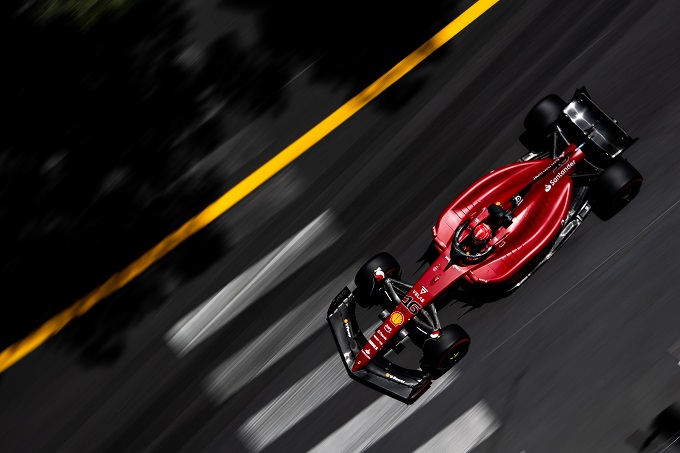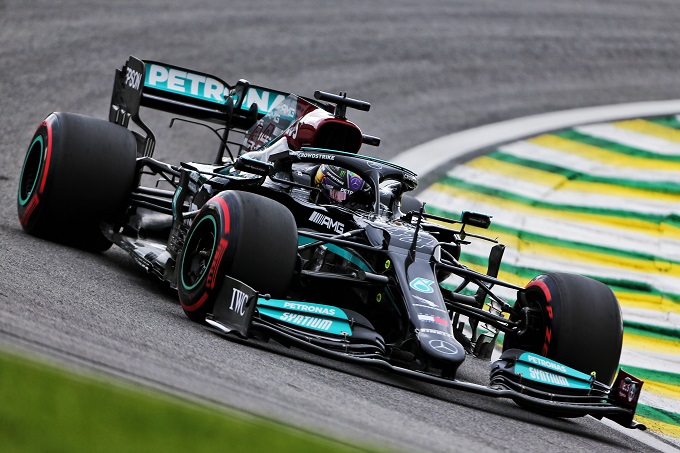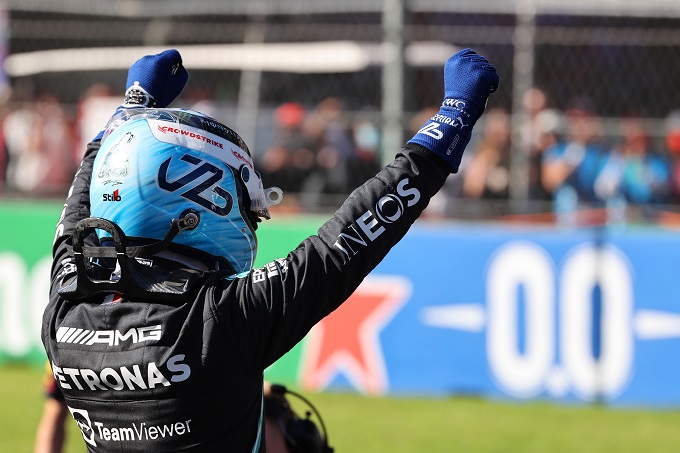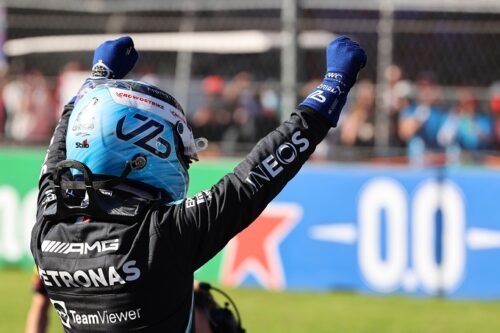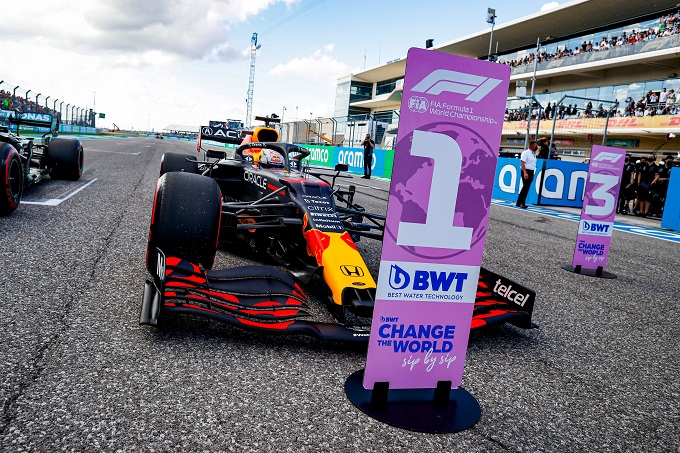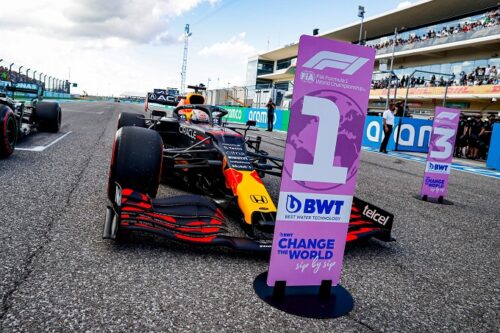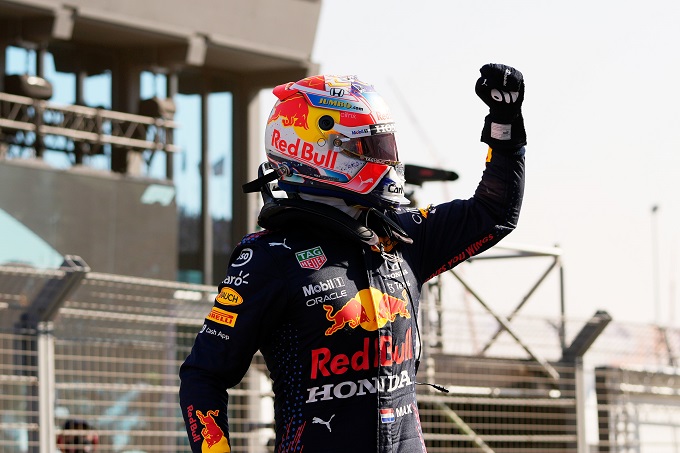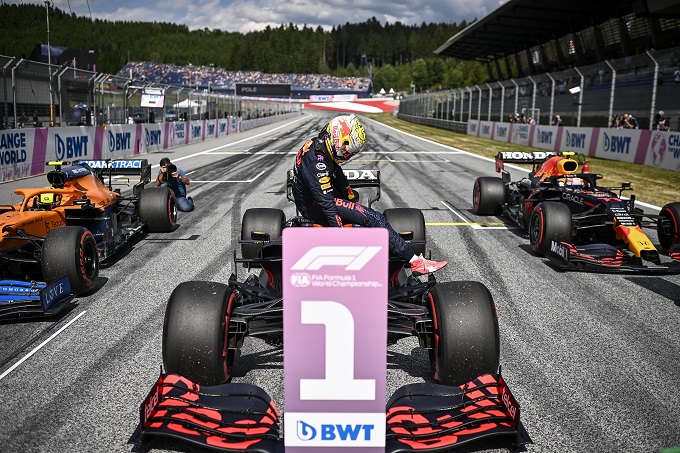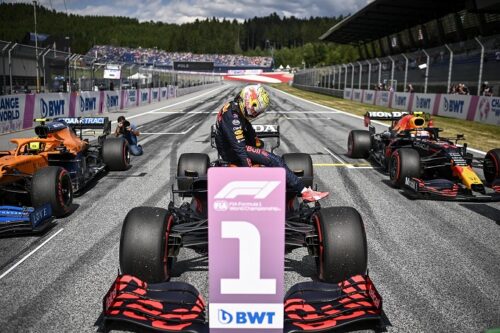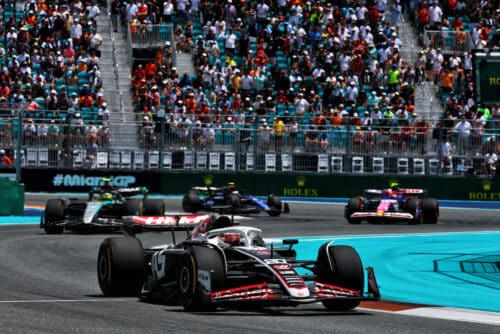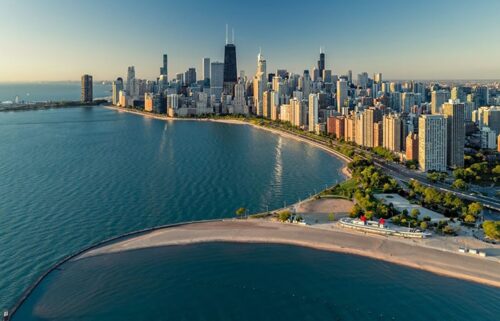F1 | Australian GP: analysis of qualifying
Leclerc wins his second pole of the season ahead of Verstappen, McLaren does well, Alpine smiles halfway

Red in the evening, hopefully good weather. With the evocative Melbourne sunset as the backdrop, the color red took center stage in qualifying for the Australian Grand Prix, like that of Charles Leclerc's Ferrari. A perfect lap at the decisive moment, as the Monegasque has often accustomed us to, which gave the Cavallino a pole position that had been missing in the land of kangaroos for fifteen years. Behind him, Max Verstappen, once again dissatisfied with the behavior of his car in the key phases of qualifying, especially in relation to the functioning of the tyres, which was too erratic in these three first rounds of the world championship.
Third place went to Sergio Perez, who missed out on a possible front row position following a derating problem on the main straight and a strategy that did not yield the hoped-for benefits. Alongside him there will not be Carlos Sainz's other F1-75, but Lando Norris, author of an excellent qualifying with a McLaren that has adapted well to the characteristics of the Australian circuit. The Ferrari Spaniard, in fact, will only start from ninth place, away from the spotlight following some unfortunate episodes and an error during his last attempt in Q3. A situation which the two Mercedes took advantage of, capable of inserting themselves and occupying the entire third row, thus obtaining a result that seemed unexpected after Saturday morning's tests. Bitter smile at Alpine, slowed down by a technical problem while Alonso was fading away in the fight to gain fourth place, confirming the competitiveness of the A522 during this weekend. Outside the top ten is Valtteri Bottas, who ends his streak of consecutive appearances in Q103 at 3.
Leclerc perfect, Verstappen once again not at ease in Q3
“I'm happy with today's result. The track is really treacherous and I have always struggled a lot here in the past. Maybe so far this weekend it hasn't seemed like that because we went very fast and instead a lot of effort was needed to optimize my performance", declared Leclerc at the end of qualifying, expressing his satisfaction with his second start from the pole during this season.
A clear pole, with almost three tenths given to his most fearsome rival, Max Verstappen who today was able to do nothing to stem the competitiveness of the Red. The time table, however, does not tell the whole story, because the levels on the field found a sort of balance compared to what was seen during the first free practices: the Ferrari which closed on the straight, limiting the gap to a few km /h, while Red Bull made a leap forward in the corners, especially in those of the last split time, although not large enough to be able to snatch first place from its rivals. A key aspect especially for the Cavallino drivers, who yesterday had a rather significant gap in the second half-time and which today, after the removal of the DRS zone, risked being even wider, given the aerodynamic choices of the Maranello engineers.
On the contrary, by reducing that difference in terms of top speed, Ferrari managed to be competitive in almost all areas of the track, from the straights to the slower corners, passing through the high-speed chicanes. Overall, the Italian car probably proved to be the best balanced and simple to push to the limit, also in terms of finding set-up, even if there was no shortage of small compromises to be effective in those sections where it suffered most on Friday. A step backwards was seen in particular in the slower corners, in particular the change of direction three/four, where the Monegasque suffered a slight understeer, although the traction qualities of the F1-75 made it possible to compensate. A stretch in which, on the contrary, Verstappen was able to take a step forward with a different approach, sacrificing turn three to get back on the accelerator first at the exit and have a better setting for turn four. Despite this sort of role swap, Ferrari still managed to be more effective, arriving at the first photocell with around a tenth of an advantage.
In the second sector the values on the field spoke of a rediscovered balance, especially in terms of top speed, but the most interesting aspect can be glimpsed upstream of that section, i.e. in chicane six-seven. Looking at the onboards, in fact, it is easy to see how the Monegasque was able to attack the external curb earlier and with greater depth, taking advantage of the painted part to bring greater speed during the journey and in the subsequent exit. An important signal, which had already been highlighted on Friday, but it is in the last half-time that the history of qualifying took on red hues.
Despite a small error at the entrance to turn 11, where he lost by a fraction of a second on entry, Leclerc was able to gain around a tenth and a half from the Hasselt driver, prevailing in the sector from turn twelve to the entry. on the starting straight. More specifically, it is worth highlighting the performance in the penultimate corner, where the two rivals for pole had opted for different approaches. Verstappen had tried to anticipate braking and follow a narrower line, attacking the inside curb to limit understeer in the middle of the corner, while Leclerc had let the car flow, being able to partialize the accelerator and guarantee himself a better trajectory at the exit. An aspect which, combined with the better stability and management of the rear in the last corner, created a combination that is difficult to beat, allowing the Monegasque to fly ahead to win his second pole of the season. A stretch of track where the Dutchman had struggled even in the first attempt, locking up resulting in the loss of the apex, although this would still not have been enough to beat the Ferrari driver.
“The weekend so far has been a bit difficult, there's a gap between Charles and me, but second place isn't bad and I think there's a lot more potential in the car than we're showing at the moment. I didn't really feel 100% in the car today, so we tried to change some things in the set up, but there weren't quite the improvements we were hoping for and we'll do the best we can tomorrow. I think we have a good car in race conditions. We hope to be able to have a good race tomorrow", explained Max. The problem of balance and tire management in Q3 which had undermined his confidence in the first two rounds of the championship therefore arises again, an aspect that Red Bull will have to work on to try to beat a Leclerc who was always on the ball on one flying lap. It will be interesting to see what influence the cancellation of the fourth DRS zone introduced this season will have, which could have been a point in Red Bull's favor if Verstappen had failed to take command of the race at the start.
Perez pays for the strategy, the episodes hit Sainz
Sergio Perez will start from third place, disappointed by a strategy agreed with the team which did not give the desired results in the last heat. For the second run, in fact, the Mexican took to the track around six minutes from the end of qualifying with a greater quantity of petrol on board, with the aim of completing two consecutive attempts on the same set of tyres. A decision probably resulting from the experience accumulated in the first two Grands Prix of the season, where it was possible to observe how even a used tire could prove competitive, but which did not work as expected: "I think qualifying was going well, especially in Q2 , but then there were red flags on a couple of occasions, meaning we weren't able to do some experiments to understand the tyres. We finally decided to do three laps carrying that much-needed extra fuel, only to discover in the end that the double attempt worked no better than a single lap. It wasn't the right thing to do and it cost us a couple of tenths, but Charles did an incredible lap, he put everything together and I didn't,” explained the driver from Guadalajara in interviews.
Regret because Perez seemed to have the potential to aim for at least the front row, so much so that he moved to the second photocell with about fifty thousandths of an advantage over his teammate. An advantage which, however, he was unable to maintain in the final sector: firstly due to an interpretation of the rapid nine-ten chicane which was not as effective as Verstappen's and, secondly, due to the derating suffered on the straight conclusive. A problem that cost him around 11 km/h in terms of maximum speed when crossing the finish line, fueling his regret that a second place was within reach, especially considering that it would have been enough for him to replicate the partial of the first attempt in Q3.
Far from the leaders was Carlos Sainz, who paid the price for some unfortunate episodes and driving errors at the decisive moment. In the first attempt of Q3, a few meters separated him from completing a lap with partials that could have guaranteed him the front row alongside his teammate, but the display of the red flag a few moments before crossing the finish line had decreed his erasure of time. Equally central was the delay with which the Spaniard was sent back onto the track in the final minutes of Q3: a problem during the ignition had limited his opportunity to get out on track well in advance to carry out a further preparation lap, in so as to bring the covers into the right operating window. To tell the truth, the split times of the last attempt indicate that in the first two sectors Carlos had even been able to improve compared to what he had done at the beginning of the heat, but a mistake in the nine-ten chicane, with the associated saving, had made it impossible for him to improve, thus having to settle for a ninth place which leaves a bad taste in the mouth. A driving flaw that cost him around 30 km/h in terms of exit speed, carrying that gap for the entire following straight. A race that will now see him forced to recover from the middle of the group, having to play for position with the other mid-table teams: the driver from Madrid will have to be particularly careful in managing the average in traffic, to avoid the graining suffered on Friday during the simulations .
McLaren surprises, Alpine with some regrets
After an uphill start to the championship, fourth place obtained by Lando Norris represents a breath of fresh air for McLaren, finally back in the top areas of the standings. Progress had already been observed in Saudi Arabia, with the team managing to come close to Q3, but on the eve of the Australian event, probably few would have bet on an MCL36 capable of taking the title of "best of the rest". Second row which can make the British driver smile again, who did not fail to compliment the team for the work done in recent weeks: “It's a great reward for the team and it's certainly the best result we could aspire to. Thanks to all the guys here at the track and in Woking for their hard work.”
A competitiveness which, however, did not deceive the technicians of the Woking team, aware that today's result may be linked more to the characteristics of the track than to the improvements made to the car: "There are some things that we did well, thanks to which we managed to extract something more from the car in terms of performance, understanding some more things and going in a different direction with the set-up" – explained Norris in interviews, underlining how a better understanding of the car helped to go in the right direction to how many concerns the structures -. “But, at the same time, I think most of the improvements are due to the track design. We haven't brought anything that has changed much, and it's not like we can do much more with the set-up to be faster", added the Briton. The changes made to the layout have undoubtedly favored the characteristics of the MCL36, which has adapted well to the smoother lines of the renewed Australian circuit, especially in the medium-medium-high speed sections which require aerodynamic load and good rear axle management. Qualities clearly visible in chicanes six-seven or nine-ten, where the McLaren confirmed itself as competitive throughout the weekend, but also when going through turn twelve, where it is essential to be precise and limit rear slippage.
That chronic lack of top speed on the long straights which, together with the slower areas, had weighed on the disappointing result in Bahrain, still remains evident: fortunately for the English team, these two aspects took on less importance in Melbourne, thus enhancing the strengths of the MCL36. Competitiveness also confirmed by the performance of Daniel Ricciardo who, in front of his home crowd, managed to achieve a good seventh place, although he did not fail to mention the difficulties in making the new set of soft tires maintained for the attack work at the time on the finale. This did not allow him to make that little extra leap to fight with the two Mercedes and improve his time recorded at the beginning of Q3, among other things on a used train that already had several laps behind him.
The smile at Alpine was more bitter, because the eighth and tenth places do not reflect the potential of a car that could aspire to a high ranking position, especially in the hands of Fernando Alonso. On the long stretches and fast curves that characterize the renovated Albert Park, the A522 flexed its muscles, showing speed qualities that were difficult for its rivals to match. Qualities visible in particular in the second sector, where the lower set-up chosen for the weekend, made even more effective by the elimination of the DRS zone on Saturday morning, gave its benefits by placing the Spaniard in a position to be able to fight for a top placing prominent. Ambitions dashed only by a technical problem, yet another, causing the impact at the exit of turn eleven which had put the two-time world champion out of the running.
A fault that the technicians are investigating, but which is added to a list that highlights how, at the moment, the Alpine's number one enemy is reliability itself. “We were very unlucky in these three races and having this problem today in qualifying is a real shame. We had the pace for the top three or maybe even for the front row today and on my lap in Q3 I felt very fast" – explained Alonso at the end of qualifying -. “I'm not surprised to be so close to the leaders because we worked hard as a team. Every weekend we improved more and more, that's positive. It was the best weekend in years for me and it's frustrating that we weren't able to finish it today.”
The good performances on the straight and in the fast corners had placed Alonso in the fight for the second row, on the edge of that thin territory between third and fourth position. With the times in the first and second halftimes essentially comparable, the fate of the challenge would be decided by the last sector, the most difficult for Alpine but also the one in which Perez had suffered derating problems. Perhaps it still wouldn't have been enough to counter the Red Bull in those low and medium mileage corners where the A522 struggles more, despite the Spaniard's talent in attacking the inside to cover as little road as possible, but it would still have guaranteed an excellent fourth place on the starting grid, giving the team the opportunity to bring home important points. His teammate, Esteban Ocon, was further behind, only eighth, and during this weekend did not shine as he did in the first two rounds of the championship, due to some feeling problems where it is necessary to know how to manage understeer. Despite today's disappointment, there is no shortage of positive aspects, not only because the car proved to be competitive, but also because the aerodynamic innovations introduced in Australia in the front area of the floor seem to have worked as expected.
Mercedes still distant
The two "Silver Arrows" inserted themselves among the McLarens, clever in taking advantage of their opponents' problems to gain a third row which represents a result beyond expectations. Without the difficulties encountered by Carlos Sainz and Fernando Alonso in the last heat, Mercedes probably would not have been able to aspire to a better position than seventh and eighth place. The W13 is still an open-air construction site, with continuous set-up changes during the weekend both on an aerodynamic and mechanical level in the hope of deepening the work of understanding a car that, for the moment, remains indecipherable. The biggest surprise was perhaps seeing a more competitive McLaren on the flying lap, because that small advantage in the medium-high speed corners highlighted in Sakhir and Jeddah disappeared in Melbourne. Despite the improvements made during the night, which helped make the tires work in a more effective operating window, guaranteeing greater confidence for the riders, this was not enough to make the hoped-for leap in quality. “We found a bit of pace overnight with the changes we made and were able to get the tires working in a better temperature region, but there wasn't much to extract from the car. The distances to Ferrari and Red Bull are still very large, but it's not a surprise for us, we know there is still a mountain to climb,” explained Andrew Shovlin at the end of qualifying. It is normal that there are circuits in which a single-seater with certain characteristics adapts better than the other, but the fact that, unlike the two previous tests, Mercedes was not able to keep up with the pace of the other top teams in any area , is undoubtedly a further alarm bell, because it indicates that there has been no progress.
Furthermore, it is worth mentioning a noticeable drop in maximum speed in the final part of the straights, especially before turn nine, which adds to the well-known shortcomings in this sector. A problem highlighted by all the cars powered by the Star Power Unit, as if it were a question of derating rather than something related to porpoising.
Alfa Romeo and AlphaTauri stop on the edge of the top ten
After 103 consecutive appearances in Q3, Valtteri Bottas had to say goodbye to his best personal streak, finding his first elimination in the second heat since 2018. An Alfa Romeo that today disappointed expectations, especially in terms of separation from those who are its closest rivals in the mid-table range, i.e. McLaren and Alpine, about half a second apart. The C42 perhaps would have benefited more from low-mileage sections, where yesterday Bottas had nevertheless proven to be quite competitive, as in Bahrain. On the contrary, today the Finn paid for a lack of performance in high-speed corners and rapid changes of direction, also suffering a gap of up to 15km/h from his competitors.
According to the Alfa Romeo driver, a possible explanation for the difficulties encountered today could be linked to the change of set-up between FP3 and qualifying to react to the elimination of the DRS zone in the second sector: “We made the decision to give priority to our set-up for the race, with a smaller rear wing, but we paid the price in qualifying. I felt like I got everything out of the car and left nothing on the table, so it's a disappointment not to be in Q3. The first run and the second were okay, but not fast enough, we were missing a few tenths. It was a bit of a surprise because I thought I was in the top ten, but the only reason I can come up with is the switch to the smaller rear wing since they changed the DRS area.” The other standard bearer of the Swiss team, Guanyu Zhou, was further behind and during this weekend had to deal with a circuit on which he had never ridden in the past, having only the laps completed on the simulator as a reference.
AlphaTauri also had to stop on the edge of the top ten, whose drivers did not hide a certain disappointment for a first part of the championship that did not provide the desired satisfaction, even here in Australia. The AT03 performed well on the slow track, also thanks to the high load offered by the chosen set-up, which however it was not able to exploit in the fastest areas of the track, also paying the price on the straights, with speeds lower even than those of the McLaren. In this respect, the elimination of the DRS zone did not help, highlighting the lack of efficiency on the reach which, instead, had made it stand out in other events. “Not getting into Q3 is always disappointing, but it was difficult for us to do so this weekend. We saw how McLaren and Alpine took a step forward and we didn't have the pace to do better. We know what to work on and have planned some updates for the next races, but missing out on Q3 by a tenth of a second hurts. We managed to make progress in some areas, but there were some gaps left throughout the weekend and so we need to look at the situation as a whole. Today we did everything we could, but I don't think Q3 was within our reach,” said Gasly, eleventh on the grid tomorrow.
Haas was more disappointing, struggling with a weekend in which it was never able to show itself to be truly competitive, highlighting difficulties in finding the correct balance and making the tires work. It was above all Magnussen who paid the price, immediately out in Q1, while Schumacher managed to access the next heat, but without ever really being in the fight with the other mid-group teams.
Concluding the grid are Aston Martin and Williams, still bringing up the rear and, despite themselves, protagonists of an eventful Saturday. The two accidents during the third free practice session had put the mechanics of the Silverstone team to the test, who in record time had to proceed with the replacement of the front suspension on both cars, as well as the gearbox unit on Vettel's . “This weekend isn't going well for us so far, but sometimes racing is like that. So what I want to do today is pay tribute to both garage teams, who were faced with the monumental task of preparing two damaged cars in time for qualifying in record time. And they did just that. Mechanics are the unsung heroes of Formula One. Well done, guys,” said Mike Krank, the team principal of the Silverstone team.
An effort thanks to which they managed to send both drivers back onto the track for the final minutes of qualifying, before a further contact knocked Stroll out of action. The Canadian, in fact, at the team's suggestion, had aborted his attempt to avoid traffic and was told to maintain his position, so that other cars could not overtake him and bother him on what should have been his final lap. However, it was precisely this desire to stay in front that had triggered the accident with Latifi, who, once he realized that his Aston Martin compatriot was no longer lagging, had decided to get back in front of him again. After the necessary analyses, the stewards decided to assign three penalty positions to the rider from Montreal, who would have still had to start from the back having not set a time. Disappointment also for Alex Albon, disqualified for the lack of fuel on board his car at the end of qualifying, of which the Federation requires one liter to carry out legality checks. A problem born from the situation that arose after the red flag caused by his teammate's accident: having to immediately return to the track to avoid traffic, the Anglo-Thai had to stop along the pit lane for several minutes, causing so cool the tires. To try to bring them back into the correct operating window and to battle with the other cars in order not to lose position, Albon was forced to perform a more aggressive out-lap, consuming more fuel than planned.
if you want to always be updated on our news
Follow us here









